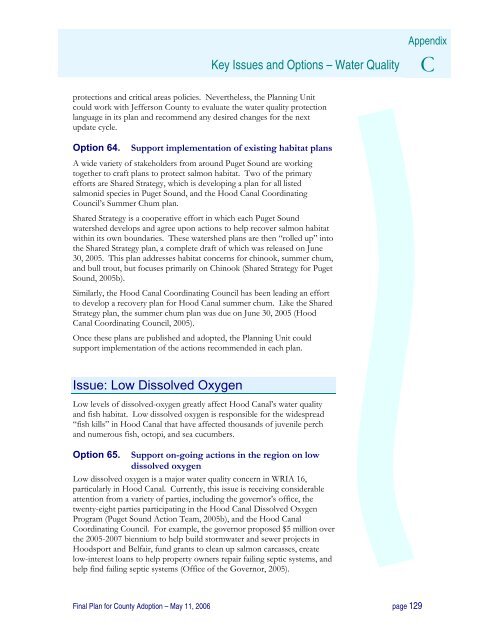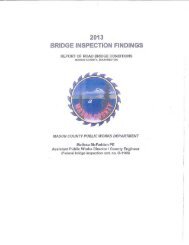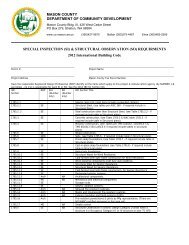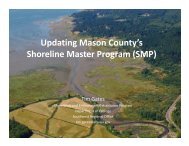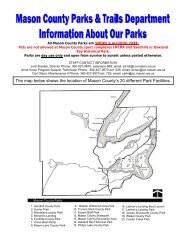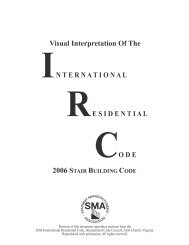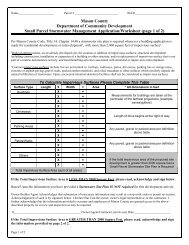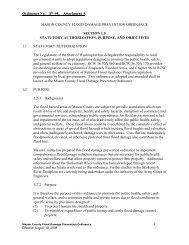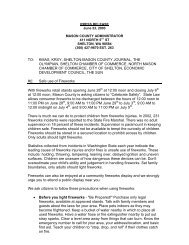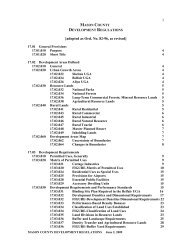Watershed Management Plan - Mason County
Watershed Management Plan - Mason County
Watershed Management Plan - Mason County
You also want an ePaper? Increase the reach of your titles
YUMPU automatically turns print PDFs into web optimized ePapers that Google loves.
Key Issues and Options – Water Quality<br />
Appendix<br />
C<br />
protections and critical areas policies. Nevertheless, the <strong>Plan</strong>ning Unit<br />
could work with Jefferson <strong>County</strong> to evaluate the water quality protection<br />
language in its plan and recommend any desired changes for the next<br />
update cycle.<br />
Option 64.<br />
Support implementation of existing habitat plans<br />
A wide variety of stakeholders from around Puget Sound are working<br />
together to craft plans to protect salmon habitat. Two of the primary<br />
efforts are Shared Strategy, which is developing a plan for all listed<br />
salmonid species in Puget Sound, and the Hood Canal Coordinating<br />
Council’s Summer Chum plan.<br />
Shared Strategy is a cooperative effort in which each Puget Sound<br />
watershed develops and agree upon actions to help recover salmon habitat<br />
within its own boundaries. These watershed plans are then “rolled up” into<br />
the Shared Strategy plan, a complete draft of which was released on June<br />
30, 2005. This plan addresses habitat concerns for chinook, summer chum,<br />
and bull trout, but focuses primarily on Chinook (Shared Strategy for Puget<br />
Sound, 2005b).<br />
Similarly, the Hood Canal Coordinating Council has been leading an effort<br />
to develop a recovery plan for Hood Canal summer chum. Like the Shared<br />
Strategy plan, the summer chum plan was due on June 30, 2005 (Hood<br />
Canal Coordinating Council, 2005).<br />
Once these plans are published and adopted, the <strong>Plan</strong>ning Unit could<br />
support implementation of the actions recommended in each plan.<br />
Issue: Low Dissolved Oxygen<br />
Low levels of dissolved-oxygen greatly affect Hood Canal’s water quality<br />
and fish habitat. Low dissolved oxygen is responsible for the widespread<br />
“fish kills” in Hood Canal that have affected thousands of juvenile perch<br />
and numerous fish, octopi, and sea cucumbers.<br />
Option 65. Support on-going actions in the region on low<br />
dissolved oxygen<br />
Low dissolved oxygen is a major water quality concern in WRIA 16,<br />
particularly in Hood Canal. Currently, this issue is receiving considerable<br />
attention from a variety of parties, including the governor’s office, the<br />
twenty-eight parties participating in the Hood Canal Dissolved Oxygen<br />
Program (Puget Sound Action Team, 2005b), and the Hood Canal<br />
Coordinating Council. For example, the governor proposed $5 million over<br />
the 2005-2007 biennium to help build stormwater and sewer projects in<br />
Hoodsport and Belfair, fund grants to clean up salmon carcasses, create<br />
low-interest loans to help property owners repair failing septic systems, and<br />
help find failing septic systems (Office of the Governor, 2005).<br />
Final <strong>Plan</strong> for <strong>County</strong> Adoption – May 11, 2006 page 129


